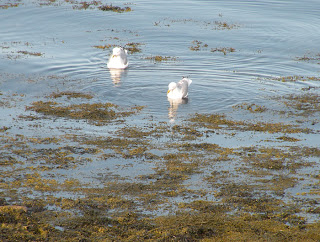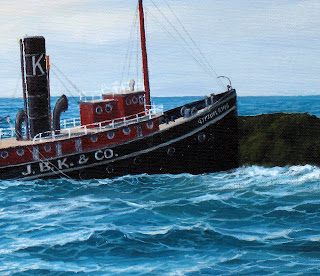As I noted in my last blog, this week's feature is quite a departure for me in subject matter: a fish; and not a fish served on a plate, but a fish swimming in its natural habitat. My subject in this painting is a "lumpfish", a fairly common visitor to our Grand Manan waters.
For someone who spent so much of his working life under the sea, you would think I would have done this sooner; but I didn't. In fact, it wasn't even my idea. The Hunstman Aquarium in St. Andrews approached me to do a painting of a sea creature for a calendar they will be publishing shortly. They wanted different artists to feature different examples of sea life in our waters. I opted to do a fish I didn't expect would be first choice for anyone else: a lumpfish, which is not a very nice name to hang on anything, especially the whimsical little fellows we share our ocean with.
I alsways enjoyed meeting up with lumpfish. They are not very strong swimmers by any standards, and they are not endowed with the heavy dentures of wolffish or the poison spines of skates. The male takes on a tangerine colour in breeding season and he dilligently guards the eggs. As defenceless as he seems, he aggresively wards off intruders who may venture too close to his beloved eggs.
One of the aspects of painting an undersea scene is the accented atmospheric perspective; where the sharp contrasts of the foreground rapidly fade as you look only a few feet to the background. This is because underwater visibility is limited to perhaps twenty feet, so things ten or fifteen feet away are very indistinct. Furthermore, blue light is diffused in the water and green penetrates the best, so the water is a bluish green. This can be seen in the area behind the fish's tail.
The tail and fins of the fish are made of spines, with a thin membrane between them. Painting the membrane was a challenge, to make them almost transparent, but with a hint of the spine colour.
The lumpfish himself was a challenge, as his skin is discoloured with little lumps and spots. His body is fairly heavily framed, and he doesn't have the flexibility of a herring or mackerel. In fact his little tail moves back and forth slowly propelling a rather ungainly block of a body. His eyes are big, dark and widely spaced on his forehead.
But I think the little fellow has lots of personality; don't you?



















